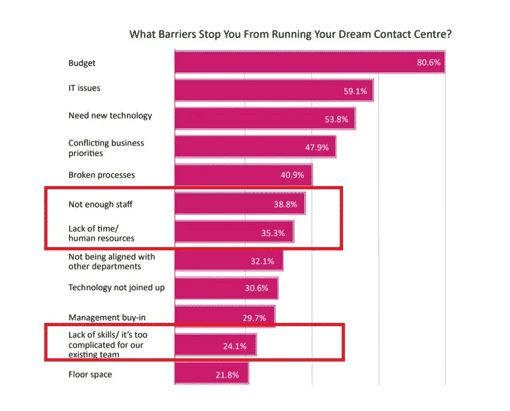Patty Yan shares insights on contact centre trends, focussing on staff retention.
Staffing is an area in which many of contact centres’ biggest hurdles emerge. Earlier in our series, we discussed the nuanced challenge of workforce management (WFM).
One of the many aspects of WFM is tracking and responding to staff attrition. Attrition or turnover is the rate at which employees leave a business. That may be by quitting, getting fired, retiring, or other related processes.
Staff turnover at contact centres is often high. That makes it an issue that operators must understand and tackle to be successful.
In this post, they’re going to examine precisely how they do so. First, they’ll cover how bad staff turnover is at contact centres, and why. Then, they’re going to look at the latest industry thinking on staff retention. Particularly, they’ll focus on how centres try to keep their best workers.
No workforce is entirely static. Whatever the industry or business, workers come and go as their circumstances change or careers develop.
It’s necessary, too, for every company – at least on occasion – to let staff go. In the contact centre niche, though, staff turnover is exceptionally high. It’s a well-known and broadly lamented aspect of the industry.
Many people who get jobs in contact centres see them precisely that way. They view them as jobs rather than careers. Workers often pass through and don’t stick around.
Research carried out by Contact Babel shows how perennial the issue is in the industry. Mean agent attrition rates in the UK have remained stubbornly above 20% each year since 2005.
Further research from the Global Call Centre Research Network is even more illuminating. It shows that high attrition is a global trait of the contact centre field.
Their study suggests that on the other side of the Atlantic, turnover is even higher. In outsourced contact centres it stands at an extraordinary 36%. Let’s put that into some context. It means that on average, around one in three centre workers will leave in the course of a year.
That’s not the end of the story, either. Attrition rates are even higher in certain types of contact centre. A US-based study suggests that in the largest centres, the rate can stand at as much as 44%. Workforces in the call centre industry, therefore, are far more transitory than most.
All that evidence of high attrition in the niche begs a specific question. That is the question of why workers leave their positions so often. There’s no one definitive answer. Instead, there are a range of factors. They all contribute to the feeling from workers that contact centre work is a stopgap:
- The job of an agent is demanding and isn’t a good fit for everybody
- Paths for promotion and career development can be limited
- Work is often repetitive
- Pay at the entry-level is comparatively low
- Seasonality of demand necessitates a large amount of temporary staff
- There’s lots of competition in the industry, and opportunity for workers to move to other centres
- Abusive or unpleasant customer interactions drive some agents out of the industry
In the face of those challenges, it’s essential for operators to focus on staff retention. If a contact centre is to survive, it must keep hold of as many talented workers as possible. What, then, do these businesses do to tackle high attrition rates?
What are Contact Centres Doing to Boost Staff Retention?
As we’ve learnt, high attrition rates are a hallmark of the contact centre niche. That doesn’t mean that operators can ignore them. Having too few staff or losing talented agents is a significant issue.
It stops centres from providing the level of customer experience they desire. A recent industry report listed the barriers operators feel stop them from running their “dream centre”.

As the graphic shows, three of the most cited barriers relate to human resources. 38.8% of contact centres stated outright that they didn’t have enough staff. Almost as many reported a lack of time or human resources, which equates to much the same issue.
Close to a quarter (24.1%) complained that their staff lacked the skills to achieve their aims.
The breadth and impact of the problem of high attrition are significant. As such, staff retention is an essential concern for contact centres. There are several ways that forward-thinking organisations are looking to boost retention:
- Introducing and expanding homeworking
- Improving company culture and employee engagement
- Enhancing worker recognition and paths for advancement
- Linking retention to hiring processes
Homeworking
As mentioned above, the job of a call centre agent can be a demanding one. There are often high expectations placed upon advisors.
When we spoke to David Rolfe at Cymphony, he told us that some agents could field 30 calls per hour. One way that centres seek to boost retention, as a result, is by making roles more attractive to modern workers.
Increasingly, the modern workforce is concerned with work-life balance. People want a job that fits better with their personal life. The contentment that can offer gets prized as highly as greater monetary reward. Contact centres can meet that desire for flexibility by introducing homeworking.
Across the niche, centres are allowing more and more agents to work remotely. A UK Contact Centre Forum survey from 2016 found that 58% of centres employed homeworkers. 69% of those firms reported that doing so created happier and more productive workers.
Contact Babel’s comprehensive whitepaper also displayed the industry trend toward homeworking. Excepting a blip in 2016, their stats show a growing proportion of home-based agents each year.
The pros we spoke to at Cymphony and FM Outsource gave us more useful insight. They further supported the idea of a significant trend toward homeworking.
At Cymphony, around 20% of agents are now based entirely at home. The company began by offering remote working to the staff at centres they took over and then closed. Today, Cymphony actively hires home-based staff.
At FM Outsource, the move toward remote working is even more marked. Marketing assistant, Charlotte Flanagan, detailed the situation at the firm. She revealed that for some of the operator’s clients, as many as 70% of agents work from home.
Company-wide, she estimated that the agent split was approximately 60/40. That’s in favour of remote workers.
The move toward higher volumes of home-based agents is only going to accelerate. As well as aiding retention, homeworking also benefits contact centres in other ways. It gives them the kind of labour flexibility that’s essential to day-by-day WFM.
What’s more, the industry shift toward cloud-based solutions also makes homeworking easier to put in place.
Another weapon in a contact centre’s staff retention arsenal is a robust company culture. Having a culture that chimes with the principles of workers helps keep them engaged. Employees who are engaged and care about the business they work for are less likely to leave.
The power of a healthy company culture was something else on which our industry pros agreed. David Rolfe from Cymphony told us that the firm had undertaken a recent culture overhaul. They’ve looked at the business as a whole, with a focus on enhancing employee engagement.
Jack and Charlotte from FM Outsource laid out how a family-oriented culture has always been central to their business.
When the company got founded in 2012, it only had five employees. Even through eight years of growth, the firm has sought to maintain a similar close-knit ethos. To support this kind of culture, FM Outsource set out serving agent happiness as a core value.
When any worker feels unappreciated, they’re more likely to look for a new position. This is an issue that’s felt even more strongly in the contact centre niche. Contact centres are often large organisations. Agents can feel like an insignificant cog in a vast machine.
They may feel that nobody would care – or even notice – if they left.
That’s why recognising agent achievement is another element vital to staff retention. There are many straightforward ways that contact centres can do so.
They include introducing rewards for outstanding performance. It can also mean highlighting superior work in front of the whole team. Offering paths for advancement is a more significant aspect of employee recognition.
When we spoke to Jack and Charlotte at FM Outsource, they raised this very point. They explained that offering new positions and greater responsibility was a way that the firm rewards the best employees. Our experts also flagged up the importance of the career history of the company’s leadership team.
Most people in senior positions have worked previously on the contact centre “frontline”. That simple fact shows agents that advancement is possible.
Linking Hiring to Retention
So far, we’ve looked at three of the most prevalent tactics call centres use for staff retention. This final point is a little different. Rather than a tactic, per se, the idea of linking hiring to retention is more of a change of attitude. It’s a way that contact centres look to mitigate the impact of natural staff turnover.
As we’ve learnt, labour flexibility is essential to contact centres. Via forecasting and WFM, centres continually reshape their workforce. That can be on a daily, weekly, monthly, and seasonal basis.
That means changeable demand will necessitate some staff turnover. One way that FM Outsource accounts for that is by tailoring its hiring accordingly.
The FM Outsource representatives explained how the company needs most staff between October and January. That means they must hire some staff on a temporary basis. For that reason, the firm focuses on taking on university students.
Those students are looking for short-term work during term-time holidays. As such, the temporary nature of hiring is mutually beneficial. A core of permanent staff that the business needs to keep, then, won’t be subject to that seasonality of demand.
Protecting a Contact Centre’s Most Precious Resource
For any contact centre operator, their workforce is their most precious resource. Without agents, customer calls aren’t answered, and other communication channels lay dormant. Unfortunately, it has long been a challenge for centres to retain their vital staff. Turnover and attrition in the niche are typically extremely high.
To meet the challenge of high staff turnover, contact centres adopt a range of tactics. Culture and employee engagement are becoming ever more critical to operators. By thinking about the ethos and philosophy of your company, you can make it a more pleasant place to work. Recognising agent achievement and allowing paths for advancement are also vital.
A route many contact centres are exploring is that of homeworking. New cloud-based solutions make it easier for agents to log on and work from anywhere.
That gives them the flexibility and work-life balance that they crave. It also helps centres develop camaraderie and a sense of team, which aids staff retention.
Author: Guest Author
Published On: 9th Jun 2021 - Last modified: 10th Jun 2021
Read more about - Guest Blogs, RingCentral















